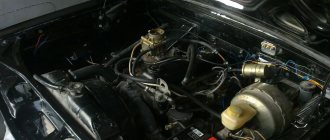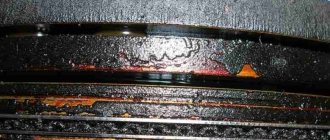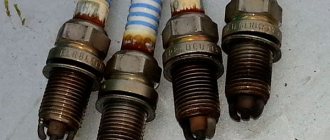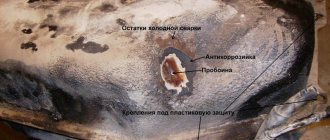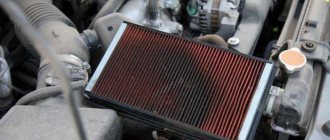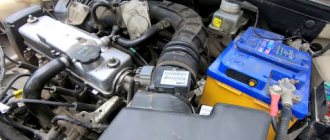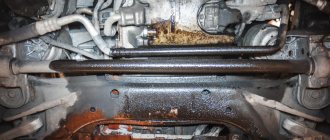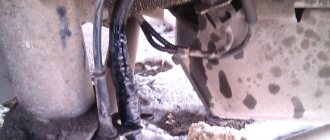Causes of oil on spark plugs
If the candles are covered with oil, then first of all it is necessary to determine exactly which part has the most of it. Many car owners are faced with a situation where only the threads and body are coated with lubricant, while the electrodes are dry and have a normal color (light brown). But it also happens that the entire base ends up in oil.
At the same time, in addition to traces of lubricant on the spark plugs, a malfunction with the engine manifests itself in other ways - deterioration in dynamics, increased exhaust smoke, oil burns. In order for it not to be the cause, it must be eliminated.
Most often, the appearance of grease marks occurs due to wear and damage:
- Valve guides.
- Oil seals.
- Valves.
- Cylinder head gaskets (cylinder head).
- CPG elements (cylinder-piston group).
Traces of lubricant on the body and threads are mentioned for good reason, since oil can get onto the spark plug not only from the cylinder, but also due to external leaks. So, on some cars, a loose fit of the cylinder head cover gasket is considered a “disease”. As a result, candles seep through leaks and get into the wells. Thus, oil accumulates in the wells of the spark plugs and when unscrewing the spark plugs, both the body and the threads are simply smeared in the accumulated lubricant. The problem is “treated” by replacing the gasket and coating it with sealant.
Oil in spark plug wells: cause of malfunction and possible consequences
Note that the appearance of oil in the area of the spark plug well is quite common on different internal combustion engines. Next, we will look at the problem using the example of 16-valve engines that are installed on the domestic Lada Priora model.
It should be separately added that such a problem can arise both on used cars and on practically new ones. In this case, this malfunction should be corrected immediately, since oil getting into the wells can lead to more serious complications.
If oil is present in the spark plug well, then this leads to softening of the rubber elements (spark plug insulator, high-voltage armored wires). As a result, spark breakdowns, cylinder misfires occur, the engine starts poorly, stalls, and loses power. In the future, various elements of the ignition system (coil, spark plugs, etc.) may fail.
We also recommend reading the article about
why do misfires occur?
. From this article you will learn about possible causes of the malfunction, as well as ways to diagnose and solve this problem.
Such failures can cause the engine “check” to light up on the dashboard, the engine requires constant computer diagnostics and error reset, not to mention the reduced service life of the spark plugs themselves, explosive wires and other parts.
So let's get back to the reasons. To begin with, oil usually enters the spark plug wells through leaks in the valve cover gasket area or through the spark plug well seals. On many engines, a rubber gasket is installed under the valve cover for sealing, and various types of sealants (anaerobic, silicone, etc.) have also recently become widespread.
Oil leaks often occur on internal combustion engines, where the valve cover is initially seated only on a sealant. In other words, the manufacturer itself does not provide for the installation of a rubber gasket in order to simplify and reduce the cost of the overall design.
Gradual drying of the sealant, errors in its application, as well as the use of low-quality compounds lead to the fact that such a seal begins to leak, much faster than a conventional gasket. Owners of the Priora model noted cases when oil appeared in the spark plug wells even on new cars. The fact is that during the long period of inactivity of the car in the car dealership, the sealant simply had time to dry out.
How to understand that the candles are flooded
First of all, you need to define the concept of “drenched candles”, that is, what is it? One of the main operating cycles of a gasoline internal combustion engine is the supply of a fuel-air mixture to the combustion chamber and its subsequent ignition. When, for some reason, the spark plug does not light it, this is called “flooding the spark plugs.”
And all because a large amount of fuel gets into the electrodes and the spark plug body. And the more fuel that gets there, the more difficult it is to ignite it, although in practice this is almost impossible until they are dried.
Most often this happens during the cold season, during significant frosts or simply during cold snaps. As drivers say, “in the cold.” During such a period, there is a heavy load on the battery and if it is weak, then there is always the possibility of flooding the spark plugs. That is, the driver tries to start the car two or three times, while the battery is discharged and the spark plugs are filled with gasoline.
However, spark plugs can be filled with more than just gasoline. two other process fluids can get on it - engine oil and coolant (antifreeze or antifreeze).
Indirect signs that the spark plugs are filled with engine oil are the following situations:
- rapid decrease in oil level in the engine crankcase;
- Unstable engine starting, and at any time of the year;
- decrease in the dynamic characteristics of the car, poor acceleration, drop in power;
- Unstable engine operation at idle speed;
- "triple" of the engine.
It is necessary to understand that the listed signs may indicate other breakdowns in the engine, so it is better to unscrew the spark plug/s from its seat and visually assess the condition of its electrodes and insulator. Moreover, it is advisable to check both for the presence of burnt oil and for the general condition. Much can be understood by color.
Similar signs will indicate that the spark plug is filled with coolant (antifreeze). In this case, there will also be a drop in engine power, a rapid drop in the coolant level, and the appearance of white carbon deposits on the spark plug electrodes and/or its insulator. You may also notice the appearance of white smoke from the exhaust pipe.
What are the causes of flooding and how does it happen?
If we are talking about the situation with flooded spark plugs, then it does not matter what exactly we have - an injector or a carburetor. These types of engines are not equipped with any special protection against possible flooding. However, after this incident the engine may not start. In addition, there may be a smell of gasoline, as well as cranking of the starter. However, it is important to see residues of oil or gasoline on the spark plugs and to notice carbon deposits.
To analyze the situation with the candles, you will need to unscrew them. The bay is quite simple. The fuel supplied to operate the engine does not ignite. At the same time, the spark plugs begin to get wet, which does not allow the engine to start as we are used to doing normally.
Why does the spark plugs fill when they are hot?
This type of malfunction, such as pouring spark plugs when they are hot, rarely occurs. Basically it happens like this: the engine started well when cold, heated up to the set temperature, drove for some time and suddenly stalled. Next, when you try to start the engine, the starter turns properly, there is gasoline, but the car does not want to start. Then, if you do nothing and leave it for a long time, the engine starts easily again. This is a sign of flooding of candles.
Reasons why spark plugs flood when the engine is hot:
- The spark plug itself is faulty (broken; the gap is either large or small;).
- The carburetor (if equipped) is not set correctly.
- Problems with the distributor (if any).
- Faulty wiring.
- Faulty sensors (mass air flow sensor).
- The high-voltage wire is broken.
- Malfunctioning injectors.
- Problems with the software (controller or firmware).
- Operating a car with a carburetor engine with an extended choke for a long time.
The way to solve the problem of flooding spark plugs in carburetor engines is to make sure that the fuel-air mixture is lean, to do this, purge for up to 10 seconds.
A way to solve the problem of flooding spark plugs in injection engines is to blow out the cylinders by opening or partially opening the throttles.
Reasons why spark plugs fill with oil
1. Insufficient battery charge is the first reason why the spark plugs fill with oil.
2. Spark plugs may flood due to engine wear.
3. Wear of spark plugs. They have their own service life and need regular replacement.
4. Malfunction of ignition system elements, for example, oxidation of contacts or wear of wires.
5.Using low-quality fuel is also a reason for spark plugs to fill with oil.
6. The accumulation of carbon deposits in the combustion chamber also leads to the spark plugs flooding with oil.
7. Incorrectly selected engine oil.
8. Incorrect carburetor setting.
9. Wear of piston rings.
10. Contamination of the oil system ventilation.
upvote this post!
Loading…
What to do if the spark plugs are flooded with gasoline
If you managed to fill the spark plugs with gasoline, there are 2 ways to start the engine.
1 way
- unscrew all spark plugs;
- we blow them out;
- let the cylinders dry for 1 minute;
- turn the starter for 5 seconds;
- screw in the spark plugs;
- press the gas pedal all the way so that the throttle opens and makes the mixture lean;
- We try to start the engine.
We recommend checking the battery voltage; if it is discharged, nothing will come of it and problems will begin already at point 4.
Method 2
- unscrew all spark plugs;
- we take them home and dry them with a hairdryer or on the stove;
- thoroughly clean the spark plugs “platinum spark plugs, iridium spark plugs cannot be cleaned”;
- while we were drying the spark plugs the cylinders dried out;
- screw in the spark plugs;
- press the gas pedal a little so that the throttle opens a little;
- We try to start the engine.
If your car has platinum or iridium spark plugs, they cannot be stripped!
For vehicles equipped with a manual transmission, it is necessary to depress the clutch pedal to the maximum to facilitate starting.
Solutions to the problem
Depending on what caused the oily spark plugs, there are several options for solving this problem: cleaning the crankcase ventilation system or decoking the engine.
Cleaning the crankcase ventilation system
The procedure is carried out as follows. After loosening the clamp, one end of the crankcase ventilation system pipe is disconnected from the air supply line, and the other from the fitting located on the cylinder head cover. After this, the hose is removed. The small branch pipe is dismantled in the same way - to do this, it is disconnected from the cylinder head and the fitting of the injection module. The supply pipe of the ventilation system is also removed after disconnecting from the BC and cylinder head fittings.
All pipes are washed with kerosene or fuel, then purged with air and dried. It would be a good idea to clean the fitting holes.
Next, the cylinder head cover is dismantled. Unscrew the screws securing the oil separator device on the inside of the cylinder head cover, remove the washers and the oil separator housing.
All grids are removed from the cylinder head. They must be washed with kerosene along with the cylinder head cover and the oil separating element.
All system components are assembled in reverse order.
Causes of oil appearing on spark plugs
The consequences of this phenomenon are quite serious:
– the engine stalls for some time after starting
– increased exhaust toxicity
– increased consumption of lubricant and fuel due to incorrect temperature conditions in the cylinders. Heavy oil burn
– an excessively high heat value leads to spontaneous and untimely combustion of the fuel mixture
– unstable vehicle dynamics
What causes problems with spark plugs?
There are many reasons, and they all occur quite often.
- Wear of the valve guides contributes to the appearance of increased play between the rod and the bushing, through which oil flows onto the piston and spark plugs. Sometimes the bushing pops out of the head, especially after repairs have been carried out
- Oil leakage from oil seals. This happens for several reasons: hardening of the seal due to excessive heat; stretching or jumping of the spring; lifting the oil seal; one-sided load leading to deformation. There is no need to change the seals, it is better to replace the entire valve
- Wear of the piston rings leads to a “pumping effect” when oil is sucked into the chamber, which can also be found on the threaded area of the spark plug.
- High oil fill level. Just drain off the excess and the problem will go away. However, an increase in the oil level can occur due to coolant leaking onto the engine sump.
- A clogged crankcase leads to an increase in gas pressure, under the pressure of which the piston rings allow excess oil to pass through.
- Worn valve stem creates a gap between it and the guide sleeve, allowing oil to penetrate through it onto the spark plugs. The problem is solved by replacing the valves
- Long-term driving with detonation, on low-quality fuel. In this case, the electrode is completely worn out or broken off, and the insulation is destroyed. All this “wealth” can get into various areas of the engine and seriously damage it.
What can prevent a spark from forming?
This question can be formulated differently - what causes a spark plug to malfunction?
- Heat cone clogged. Prolonged unsuccessful cold starting of the engine leads to the accumulation of oil and carbon in this area. After the car has been parked for a long time, attempts to start it cause it to stall, but after warming up, the symptoms disappear. The diagnosis here is clear - insufficient spark plug temperature or presence of oil in the cylinder. “Cold” spark plug, wear of bushings and rings, increased oil consumption - you need to pay attention to this when checking.
- Coking of the space between the body and the thermal cone. Oil combustion products form a coke layer. The reason is incorrect functioning of the carburetor or injector, faulty sensors (for example, oxygen), problems with the throttle drive, or clogged air filters. Burnout of the electrodes leads to expansion of the gap. The danger lies in the increased risk of breakdown in different places and premature ignition of the fuel mixture.
- Destruction of the spark plug - melting of the electrodes, cracking and destruction of the insulation and cone. This is a consequence of prolonged driving on a lean mixture, with increased loads. Overheating of the cylinder chamber leads to “burning” of the exhaust valves. The reasons may be: too high heat rating of the spark plug (“hot” variety), too much ignition timing, poor fuel quality and a lean fuel mixture. Residual glow ignition may occur when, even after shutting down, the engine does not turn off for some time. The spark plug is overheated, it needs to be changed (select “cold”).
- Leakage of gases through a leaky seal. There is a risk of breakdown of the tip and contamination of the outer surface of the insulator. The appearance of a reddish coating is explained by the use of gasoline with a high content of lead and manganese (added to increase the octane level). This significantly reduces sparking. Prolonged use of such fuel will lead to the formation of a deposit on the outer surface that conducts electric current. Current passes through it more easily than through electrodes. As a result, the candle stops functioning.
- The appearance of oil and gasoline droplets on the spark plugs. A common reason for this is a problem with the injector (it leaks). In winter, gasoline vapors do not evaporate, settling on the candles. There is a treatment - remove them, clean them with alcohol and dry them.
What to do when pouring candles
Vehicle manufacturers advise removing the spark plugs first. Then you need to dry the part, start cranking the engine with no spark plugs for 10 seconds. After this, the dried part will need to be returned to its place, after which you can try to start the engine. If time is short, you can start the engine with cylinder purging.
To do this, in the case of an injection engine, you need to squeeze the gas all the way, then crank the starter for about 10 seconds. After this, the gas pedal should be returned to its original position. This way there will be more air in the cylinders, and the spark plugs will dry out accordingly.
Cleaning
If the spark plugs are dirty, then it is not at all necessary to immediately replace them with new elements of the ignition system, igniting the fuel mixture in the combustion chamber of the VAZ 2110. Regular cleaning will quickly remove the dirt and return the spark plugs to their previous functionality.
There are several common cleaning methods that can be used at service stations and in garages with your own hands.
Regardless of the chosen method, we recommend that you follow the general principles of operation when cleaning the elements of the ignition system.
- Protect the coating of the spark plugs from abrasion; do not use rough sandpaper or other similar abrasives.
- Do not expose the candle to high temperatures. It is not worth heating them over a fire for the purpose of cleaning. Some people do this for some reason.
- Check the spark plug for resistance using a megometer. If the second scale does not show + infinity, then the spark plug will have to be changed. Cleaning is useless. With a value of 1000 it is also better not to try to resuscitate the element.
Now let's talk directly about cleaning methods.
Cleaning before and after
The formation of carbon deposits and flooding will require not only removing and drying the spark plugs, but also thoroughly cleaning them.
- One popular method is to remove carbon deposits with a fine-bristled wire brush;
- Another option is treatment with kerosene, which removes carbon deposits quite effectively;
- Another method involves the use of sandblasting. The effectiveness of this approach is short-term, so you will soon have to remove the candles again and clean them;
- Many people have also gotten used to using chemical converters. To do this, candles are placed in a solution, allowed to sit for about an hour, after which they are cleaned with matches, toothpicks to remove carbon deposits, washed with water and dried;
- In order not to buy specialized products, you can use acetone using the same cleaning principle;
- Our grandfathers cleaned candles with vinegar. To do this, you will need to dip them in vinegar for an hour, then add literally 5 drops of electrolyte;
- There is an ultrasonic cleaning method, but this requires specialized equipment.
Article on the topic: Diagnostics and replacement of the fan sensor on a VAZ 2114
If you do not get the desired result, you will have to change the candles. But first they need to be selected.
What to do if the spark plugs are filled with antifreeze
The main reasons for this malfunction are burnout of the cylinder head gasket and violation of the head geometry
. As a rule, this occurs after repeated overheating of the engine. If the geometry is violated, the head must be ground; this is a complex and expensive service.
The most difficult situation is a violation of the geometry of the cylinder head. Not every service station will be able to fix the problem, and if they do, they won’t give you a 100% guarantee. If you have an old engine, it is more profitable to replace it with a contract one.
How to determine if there is a problem
If you are not a seasoned car enthusiast and the phrases “troubling the engine” cause you slight bewilderment, the only possible way to check the performance of the spark plugs is to look. Upon visual inspection, a candle that has been in oil for a long time will have a characteristic soot (its end will be completely black).
If the candle has spent a little time in the “pool”, it will just have oil at the end. You need to know these characteristics, because the longer you use a car with flooded spark plug wells, the more likely you will be to stand in the middle of the road, wondering why the car doesn’t go further. You can also determine that there is oil in the spark plug well by increasing the engine starting time.
Why are the candles flooded?
Let's first look at the reasons why the spark plugs on the injector are flooded. To do this, consider the operation of a car starter.
Thanks to the operation of its pistons and valves, a mixture of gasoline and air is supplied to the combustion chamber, which is ignited by a spark generated by the spark plugs. After ignition, the starter turns off. Thanks to ignition, the engine cylinders start working. To successfully start the engine, you need a working starter, a powerful battery and a favorable ambient temperature.
At low temperatures, gasoline does not mix well with air. It is known that frosty air contains more oxygen. An increase in oxygen content requires the supply of more gasoline. The vehicle's electronic control unit sends a signal to the fuel injectors, which increases the fuel supply. Thanks to the starter, compression is created in the cylinders and at the same time a spark is formed to ignite the fuel mixture. But since the compression does not meet the standards and the spark is weak, the incoming gasoline will flood the spark plugs, preventing the mixture from igniting. This is the reason why candles are poured in cold weather.
The formation of a spark is influenced by the following factors:
- Gasoline quality. It should not contain many impurities and dirt, as this will affect the operation of the injectors.
- Engine wear. If the engine pistons are worn out, they do not create the necessary pressure and fuel may flood the injector.
- Quality of candles.
- Quality of injector and carburetor.
- Battery power: You should monitor its charging.
If the compression is ideal, the engine will start even with minimal impulse and fuel fluid will never fill the injector. But only a new car can boast of such compression. If a car, for example, such as a VAZ, is more than three years old, gasoline fills the spark plugs on the injector more often.
What's the result?
- As a rule, it is possible to solve the problem of oil in spark plug wells with minimal financial costs. Even if you purchase an expensive professional sealant, the price of a small tube remains quite affordable.
- We would like to add that in some cases it is not necessary to change the spark plugs at the initial stage, but it may be necessary to clean the spark plugs separately. Only after removing dirt and carbon deposits will the power unit operate stably and smoothly.
- If mistakes were made during the application of the sealant, then the oil leak may continue in the future. For example, anaerobic sealants only cure when there is no contact with air. It turns out that if it is not possible to achieve a tight fit of the surfaces, then the composition will remain liquid and the seam will not be sealed.
Why oil leaks from under the gasket or valve cover housing: causes of lubricant leaks. How to fix an oil leak from under the valve cover yourself.
Why oil leaks from the engine breather: signs and main causes of such a malfunction. How to understand why oil is flowing through the breather, troubleshooting.
Causes of oil leaks in the oil filter area: oil flows from under the filter, through the housing, in the area of the fitting, etc. Available diagnostic and repair methods.
Why does engine oil start to drip or leak at the junction of the engine and gearbox. How to accurately determine the cause of a lubricant leak, methods of diagnosis and repair.
Crankshaft oil seal leak: how to determine the location of the leak yourself. Why the current crankshaft oil seal needs to be changed urgently, how to change the front and rear oil seals.
Prevention is the best way to prevent candles from flooding
To prevent the spark plugs from flooding, you need to maintain your car properly.
- charged battery;
- good condition of high-voltage wires;
- serviceable ignition coils;
- clean injector nozzles;
- MAP sensor or mass air flow sensor is working properly;
- clean fuel filter.
If your car regularly does not start
Because the spark plugs are flooded, the reason should be sought not in the spark plugs themselves, but in the computer, wiring or sensors.
In the event that the car is flooded with 1 or 2 spark plugs
, and the rest of the spark plugs are fine, the problem may be in the injectors which, due to their poor performance, are unable to fill the rest of the spark plugs or the computer.
It's better to warm up your car in winter
, having spent a liter of gasoline overnight, rather than unscrew flooded spark plugs in the cold, wasting your nerves and time.
